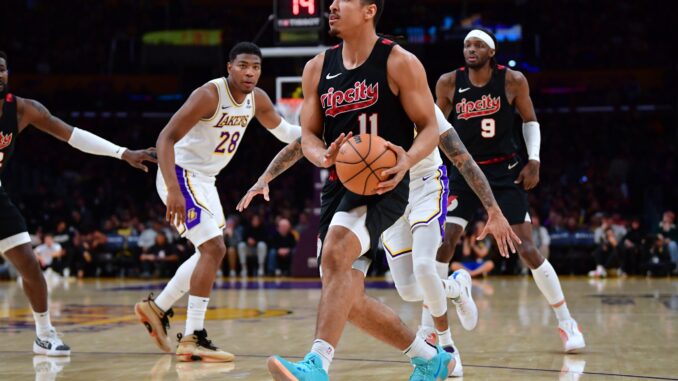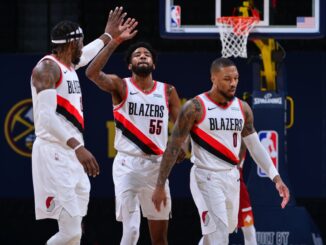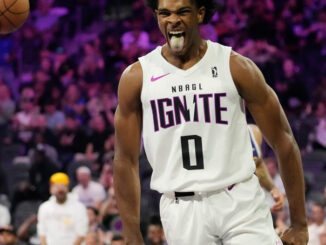
Heading into the All-Star break, the Portland Trail Blazers have had an interesting season. From the trade of Damian Lillard up to the current day, let’s review the top five things we’ve learned about the Portland Trail Blazers this year.
The Offensive Effectiveness of Simons
After Damian Lillard was traded, Anfernee Simons was thought to be the next up for scoring on this team. Simons took over the scoring load, averaging the most points per game on the team (23ppg). Drilling into that, he’s averaging 25 points per game, six rebounds, and four assists per 36-minute stats. While Simons is on the court, the offense fairs better overall, turning the ball over 2% less (15% to 13%). He’s not at Lillard’s level yet, but he’s been consistently improving his stats every year. Even more exciting for Simons is his slight increase in free throws. While it’s only 1.5 to four attempts per game, he’s shooting them between 88% to 90%. Bump that up to seven to eight attempts per game, and we could be on the precipice of a thirty-point scorer on the team. Oh, and he’s only 24 years old.
The Ineffectiveness of Ayton
Included in that Damian Lillard trade was shipping out Jusuf Nurkic for Deandre Ayton. Initially, I was excited for this trade, as Ayton is comparable to Nurk but could score more. Unfortunately, that scoring ability has escaped Ayton. Nurk and Ayton are only split by 1.5 points per game. As I write this, Ayton has a career-low of 13.5 points per game. The main difference between Nurk and Ayton’s play style is that Nurk learned to shoot three-pointers to fit in with the team’s offense. Ayton has yet to attempt a three this year, which is no surprise. Ayton’s play style is that of a traditional mid-2000s center called “back to the basket.” It means exactly what you think: post up the defender with your back to the basket and use post moves to score. The NBA is going away from that, so Ayton will need to adapt. Ayton’s mental gaffs are noticeable, too. While defensively, his advanced stats are decent (second-best defender on the team by DRtg), Ayton gets lost on pick-and-roll assignments routinely, and when faced with a one-on-one, he seems to relax and becomes slow to respond. There’s an amusing video where Nikola Jokic pump fakes, and Ayton puts his hand up to contest. He turns his back to Jokic, and Jokic drives right by him. I look for Ayton to pick up his scoring after the All-Star break, with other top scorers like Shaedon Sharpe on the shelf for a bit.
Sharpe Is Not Offensively Ready
Speaking of Shaedon Sharpe, he was another player thought to have taken over the scoring duty in Lillard’s absence. While Sharpe is averaging six points per game more than last year (ten to 16), he is shooting much worse. On 8.1 attempts the previous year, Sharpe was shooting 47.2%, which is respectable for his play style. This year, he’s averaging 40.6% on 13.6 attempts. I understand that Sharpe is only in his second year, but as the clear third scoring option on the team behind Simons and Jerami Grant, you want that third guy to be as efficient as possible. To go even further, the Blazers are better offensively with Sharpe off of the court. When he’s on the court, the Blazers have an offensive rating of 107.3. Off the court, it’s 111.8. The light here is that Sharpe is an average defender for them, partially thanks to his excellent athleticism and being next to Matisse Thybulle.
Scoot’s Not The Rookie Of The Year
There are plenty of articles about Scoot Henderson’s struggles this year, so I will get right to the point. The dark horse pick for Rookie of the Year has a -1.2 Win Shares this year, meaning that Scoot playing this season has lost the Blazers 1.2 games. Scoot’s known for his elite athleticism, but he needs to remember how to finish when he gets to the rim. He’s not thinking ahead, only focusing on his move at that moment. We knew he would be a terrible three-point shooter, but he’s been average at about 33%. His early stats, specifically the magical per 36, remind me a lot of Eric Bledsoe (17 points, six rebounds, five assists), which wouldn’t be a bad career. His defense is also suspect, where the opposing team’s offensive rating increases by about five points with Scoot on the court.
Team Defensive Improvement
Over the past three years, defense has always been an area for improvement. Bringing in coach Chauncey Billups, a pivotal piece of the Detroit Pistons team that won the NBA Finals off being the best defensive team of the 2000s, was supposed to address that. In his first season as the coach, the team had the worst defensive rating of any team. Last year, they finished 27th. This year, though, the Blazers are up to 22nd in the league in defensive rating. A big part of this was the acquisition of Matisse Thybulle. Thybulle ranks third in steals, second in defensive box +/-, and first in steal percentage. What makes Thybulle so potent is that next to him are athletic wings, whether it be Scoot, Sharpe, or Simons. Coach Chauncey funnels the team’s best offensive players towards Thybulle by playing a mixture of zone and man, sometimes a box and one. For those who don’t know, a box and one is when four defenders stand at each corner of the paint while the “one” floats around. That “one” is Thybulle. This defense allows him to be active in the passing lanes, which is evident by his steals. They do still have room to improve defensively, especially on the fastbreak. The Blazers rank 29th in opponent fastbreak points and 26th in opponent points in the paint. Both of these are related where typically, on fastbreaks, the paint is open while the big man thunders back down the court.
When a team performs like the Portland Trail Blazers did in the first half of the season, it’s easy to be negative. There are always some positives about a team; you may have to look a little deeper than traditional stats. I look forward to seeing the Blazers improve upon their first half, but they will get some much-needed rest during the All-Star break.



